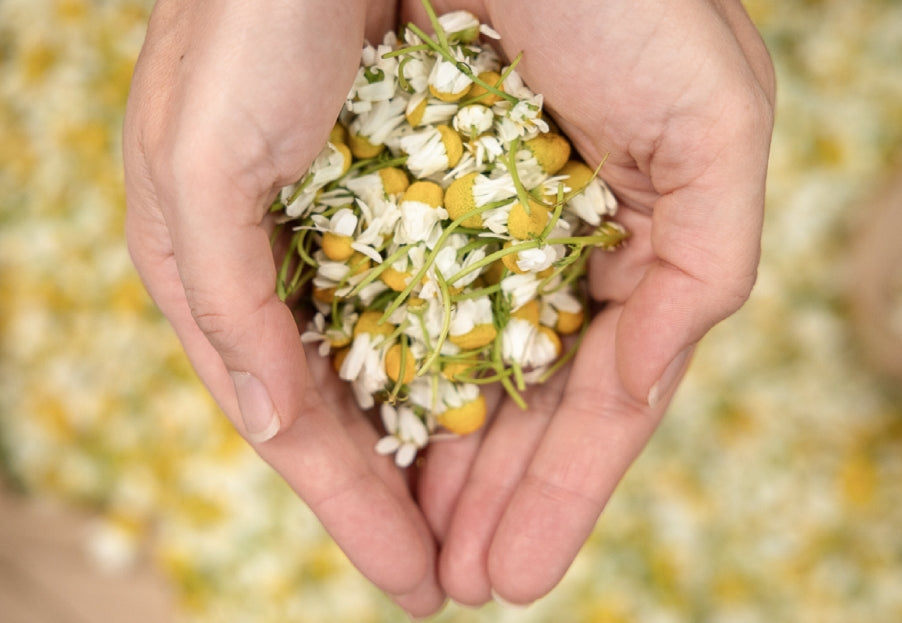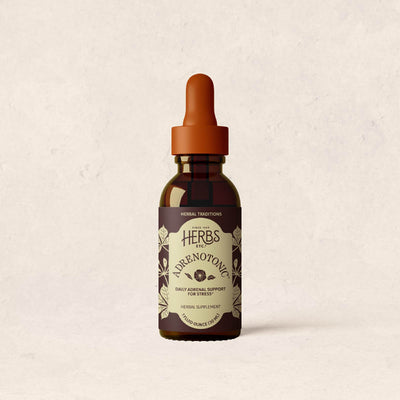Why and When We Use Fresh Herbs

Written by Blaire Edwards-Maschotta.
There’s nothing like the sensation of a bundle of fresh herbs - from the smell that enchants memory to flavor that tastes like its straight from the garden. Fresh herbs are exactly that, herbs that are fresh and alive, which we process on-site within 24 hours of harvest to capture all the rich properties the plant has to offer.
Volatile Oils: Fleeting, Fragile, and Full of Power
The simplest way to explain why fresh herbs have a place in herbal medicine is to think about what form of basil you would want to use when making pesto, or what mint you would want in a mojito. Both Basil and Mint are aromatic members of the Lamiaceae family and are rich in volatile oils [aka essential oils]. If you couldn’t tell by the name, volatile oils aren’t exactly stable. They evaporate into the air pretty quickly and are very sensitive to light and temperature, which is why using dried Basil or dried Mint isn’t the most delicious option for pesto or mojitos - and it’s also why dried isn’t the most potent option when extracting aromatic herbs for tincturing.
Why We Extract Aromatics Fresh
We use fresh herbs when we want to capture and utilize their aroma and their volatile or essential oils. For example, Lemon Balm (Melissa officinalis) contains a number of essential oils we want to capture, such as citral, which has antimicrobial and antispasmodic activity, and citronellal, which has calming properties, (2, 3).
Of course, it’s important to note that aromatic herbs have many active constituents outside of their volatile oils. While both the extract and the essential oil of Lemon Balm have been shown to have calming, anti-anxiety qualities, one study showed that the water extract of Lemon Balm possessed specifically sedating effects that the essential oil on its own did not, (1). Other aromatic herbs we extract fresh include Catnip (Nepeta cataria), Chamomile (Matricaria recutita), Garlic (Allium sativum) and Yarrow (Achillea millefolium).
When Fresh Is the Only Option
Other herbs, like Cleavers (Galium aparine), Fresh Milky Oats (Avena sativa) and Jewelweed (Impatiens capensis) are extracted fresh not because they are rich in volatile oils but because they lose their activity immediately (Fresh Milky Oats) or very quickly (Cleavers) upon drying. For example, you might see people in the industry selling “oat straw” and claiming the same nervous system supporting benefits as Fresh Milky Oats, but Oat Straw and Fresh Milky Oats are not the same. Fresh Milky Oats are harvested in a very narrow window of time when the seed is full of white, milky liquid. That liquid is what we are aiming to harvest, not the oat straw or the oats themselves.

Photo of Fresh Milky Oats Harvest - Harvested in 2019 in the Santa Monica Mountains, an area where I spent a lot of time removing invasive species.
Saw Palmetto (Serenoa repens) is extracted fresh because once dry, the berries turn a dark purple color, regardless of if it was harvested when ripe or unripe. Receiving Saw Palmetto in its fresh state allows our extraction team to make sure each extraction is made with the properly harvested berry, for maximum benefit and potency.
Timing Is Everything
Fresh herbs remind us that herbalism is a living practice - one that requires timing, skill, and deep listening. When we choose to work with fresh plants, it’s not just for potency, it’s to capture the essence of a moment in the plant’s life, when its chemistry, energy, and intelligence are at their peak. From the milky sap of an oat seed to the citrusy lift of Lemon Balm, these fleeting qualities don’t wait around. That’s why we extract within 24 hours of harvest to preserve what the plant is offering, in full. It’s precise, it’s time-sensitive, and it’s worth it. Because when it comes to fresh herbs, timing is everything and so is trust in the medicine.
Bibliography
-
Emamghoreishi, Masoumeh & Talebianpour, M.S.. (2009). Antidepressant effect of Melissa officinalis in the forced swimming test. Daru. 17. 42-47.
-
Abdellatif F, Akram M, Begaa S, Messaoudi M, Benarfa A, Egbuna C, Ouakouak H, Hassani A, Sawicka B, Elbossaty WFM, Simal-Gandara J. Minerals, Essential Oils, and Biological Properties of Melissa officinalis L. Plants (Basel). 2021 May 26;10(6):1066. doi: 10.3390/plants10061066. PMID: 34073337; PMCID: PMC8229312.
-
Kucharska M, Szymańska JA, Wesołowski W, Frydrych B, Bruchajzer E. Analiza lotnych składników wybranych olejków eterycznych o działaniu relaksacyjnym [Analysis of volatile ingredients of selected essential oils listing relaxing action]. Med Pr. 2019 Apr 19;70(2):229-247. Polish. doi: 10.13075/mp.5893.00784. Epub 2019 Mar 19. PMID: 30912530.


Written by Blaire Edwards Maschotta - HERBALIST & PRODUCT DEVELOPER





